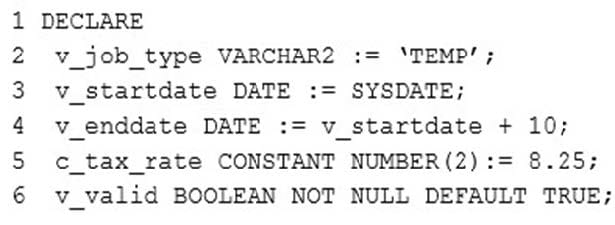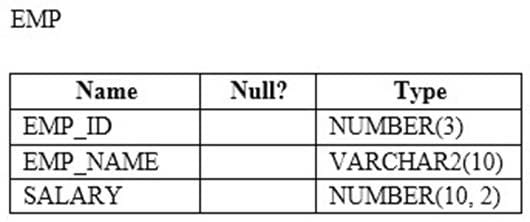Exam Details
Exam Code
:1Z0-144Exam Name
:Oracle Database 11g: Program with PL/SQLCertification
:Oracle CertificationsVendor
:OracleTotal Questions
:106 Q&AsLast Updated
:Aug 06, 2025
Oracle Oracle Certifications 1Z0-144 Questions & Answers
-
Question 21:
View the Exhibit and examine the code:

Which statement is true about the COMPILE_CODE procedure?
A. It gives an error in line 6.
B. It gives an error in line 8.
C. It gives an error in line 5.
D. It executes successfully, but displays a warning about the unreachable code when used for the PROC1 procedure.
E. It executes successfully, but a warning about the unreachable code is not displayed when used for the PROC1 procedure.
-
Question 22:
You create a procedure to handle the processing of bank current accounts which rolls back payment transactions if the overdraft limit is exceeded.
The procedure should return an "error" condition to the caller in a manner consistent with other Oracle server errors.
Which construct should be used to handle this requirement?
A. The SQLERRM function
B. The PRAGMA EXCEPTION_INIT function
C. The RAISE_APPLICATION_ERROR procedure
D. A user-defined exception used with a RAISE statement
-
Question 23:
Examine the following DECLARE section of PL/SQL block:

Which line in the above declarations would generate an error?
A. Line 2
B. Line 3
C. Line 4
D. Line 5
E. Line 6
-
Question 24:
Which statement is true about transactions in PL/SQL?
A. A transaction can span multiple blocks.
B. A block can contain only a single transaction.
C. SERVERPOINTS cannot be created in a PL/SQL block.
D. The END keyword signals the end of a PL/SQL block and automatically commits the transaction in the block.
-
Question 25:
Which statements are true about the WHEN OTHERS exception handler? (Choose two.)
A. It can be the first exception handler.
B. It can be the only exception handler for the code.
C. It traps all the exceptions that are not already trapped.
D. You can have multiple OTHERS clauses to trap all the multiple unhandled exceptions.
-
Question 26:
View Exhibit 1 and examine the structure of the EMP table.

View Exhibit 2 and examine the PIVSQL block of code.

What is the outcome?
A. It gives an error because the return type is not valid.
B. It gives an error because the record type is not defined within the function.
C. It gives an error because the function call in DBMS_OUTPUT. PUT__LINE is not valid.
D. It executes successfully and displays the names and salaries of all employees who earn the highest salary.
E. It executes successfully but does not display the names and salaries of all employees who earn the highest salary.
-
Question 27:
Examine the following package specification:

Which statement is true?
A. g_comm has a value of 15 at 9:06 AM only for Jones.
B. g_comm has a value of 10 at 9:03 AM for both Jones and Smith.
C. g_comm has a value of 15 at 9:03 AM for both Jones and Smith.
D. g_comm has a value of 20 at 9:06 AM for both Jones and Smith.
-
Question 28:
Identify situations in which the DBMS_SQL package is the only applicable method of processing dynamic SQL. (Choose two.)
A. When a query returns multiple rows
B. When a column name in a where clause is unknown at compile time
C. When the number of columns selected in a query is not known until run time
D. When a table needs to be created based on an existing table structure at run time
E. When privileges need to be granted to a new user to access an existing schema at run time
-
Question 29:
Examine the following block of code: Which two statements are correct about the code above? (Choose two.)

A. The function goes through only the parse and executes phases.
B. The function goes through the parse, bind, and execute phases.
C. The function goes through the parse, bind, execute, and fetch phases.
D. All the processing phases for the function are performed only at run time.
E. Only the EXECUTE IMMEDIATE statement inside the function is parsed at run time.
-
Question 30:
Identify the scenario in which you would use the CURRENT OF clause for an UPDATE or DELETE statement to rows fetched from a cursor.
A. when you want to lock the rows fetched by the cursor
B. when you want to update or delete the result set without affecting the rows in the table
C. when you want the database not to wait if the requested rows are locked by another user
D. when you want to ensure that the current rows fetched by the cursor are updated or deleted
Related Exams:
1Z0-020
Oracle8i: New Features for Administrators1Z0-023
Architecture and Administration1Z0-024
Performance Tuning1Z0-025
Backup and Recovery1Z0-026
Network Administration1Z0-034
Upgrade Oracle9i/10g OCA to Oracle Database OCP1Z0-036
Managing Oracle9i on Linux1Z0-041
Oracle Database 10g: DBA Assessment1Z0-052
Oracle Database 11g: Administration Workshop I1Z0-053
Oracle Database 11g: Administration II
Tips on How to Prepare for the Exams
Nowadays, the certification exams become more and more important and required by more and more enterprises when applying for a job. But how to prepare for the exam effectively? How to prepare for the exam in a short time with less efforts? How to get a ideal result and how to find the most reliable resources? Here on Vcedump.com, you will find all the answers. Vcedump.com provide not only Oracle exam questions, answers and explanations but also complete assistance on your exam preparation and certification application. If you are confused on your 1Z0-144 exam preparations and Oracle certification application, do not hesitate to visit our Vcedump.com to find your solutions here.